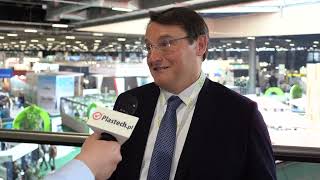
“The investment costs for complete pipe extrusion lines quickly pay off thanks to us”, Andreas Türk, Director Sales Infrastructure at battenfeld-cincinnati GmbH, Bad Oeynhausen, is certain. After all, the components of a complete system are not only perfectly matched to each other but are also technically designed to save both energy and raw material costs compared to similar systems. Thanks to minimized production costs, the investment costs are amortized after just three to four years. This means that the pipe manufacturer saves money during the entire service life of a pipe line of around 15 years or more and benefits from the high end product quality and a reduced CO2 footprint.
The extruder is not only one of the most important core components in every pipe line, but also the largest energy consumer, accounting for up to 80% of total energy consumption in some cases. “Thanks to the process engineering design of the new solEX NG single-screw series, we have managed to reduce energy consumption by around 15% compared to previous generations,” emphas Andreas Türk. The main reason for this improvement is the internally grooved barrel, which has a low axial pressure profile in combination with the matching screw geometry. This leads to both reduced energy consumption and less machine wear. At the same time, the new processing unit ensures a very gentle and homogeneous melting performance at around 10 °C lower temperatures.
The second core component of every pipe line is also indispensable: the die. helix dies from battenfeld-cincinnati not only score points with the unique and patented process engineering combination of screen basket distributor and spiral mandrel, but due to their design also with 10% lower energy costs for the heating capacity compared to conventional pipe heads. In addition, the screen basket homogenizes the melt thermally and mechanically, which leads to a further improvement in product quality. The third important factor influencing the overall energy consumption of a pipe line is the cooling and therefore the downstream units, consisting of vacuum tanks and spray baths. The green line concept works with frequency-controlled pumps and a very efficient water supply, both of which help to reduce energy costs.
With an energy-efficient complete system set-up consisting of solEX NG, helix die and green line downstream equipment, around EUR 85,000 in energy costs can be saved per year, calculated with 7,000 h production p.a. and 12 Eurocent per kWh, when producing a 250 mm PO pipe with SDR 11 and an output of 1,000 kg/h. With a conventional energy mix, this corresponds to a CO2 equivalent of 315,000 kg.

As with the energy costs of the extruders, material consumption is the main factor influencing production costs: around 85% of production costs are attributable to the raw material used. “For ecological and economic reasons, we have to make sure that little scrap is produced, and that the production of good products is carried out within the narrowest tolerances,” says Andreas Türk, explaining that the line components from battenfeld-cincinnati are designed precisely for this purpose. Thanks to the combination of the screen basket distributor and the spiral mandrel of the helix pipe heads, the melt is distributed more precisely, which is particularly evident with thicker wall thicknesses. Due to the improved melt quality, the tolerance ranges of the wall thicknesses in the pipe can be significantly reduced. In addition to the gravimetric dosing system, which ensures exact quantity dosing, and the extruder, which works with a minimum throughput fluctuation, the inline wall thickness control and the centering aid inside the die head are also responsible for exact wall thickness distributions and low tolerances in the pipe lines. Precise wall thickness distributions in turn minimize material consumption. Here is an example: If the target wall thickness of 6.2 mm of a 200 mm PO pipe with SDR 33 varies within a narrow tolerance range between 6.22 and 6.48 mm instead of the usual up to 7 mm, around 1 million euros in raw material costs can be saved per year at a throughput rate of 1,000 kg/h and calculated with 1.50 Euro per kg/HDPE and 7,000 h production p.a. Due to the design of the tools fast color change times support the raw material savings.
In large-diameter pipe production, the so-called sagging effect is particularly important for the economic efficiency of a line. If this can be prevented as far as possible, it makes a decisive contribution to the efficiency of the line. Here, too, considerable improvements have been achieved in recent years through new developments in the area of the pipe head.
“Thanks to the combination of minimized energy and raw material costs, our pipe lines are economically very attractive. The process engineering design of the NG series also increases product quality and minimizes scrap and overweight. A win-win solution, both economically and ecologically,” summarizes Andreas Türk.


